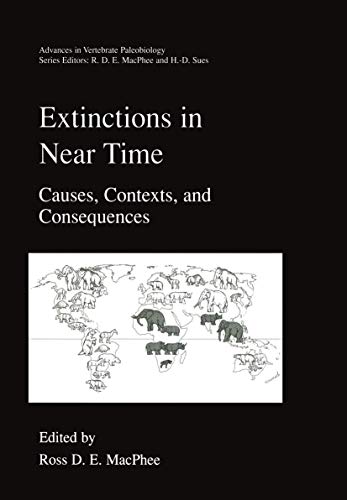Verwandte Artikel zu Extinctions in Near Time: Causes, Contexts, and Consequences...
Extinctions in Near Time: Causes, Contexts, and Consequences: 2 (Advances in Vertebrate Paleobiology, 2) - Hardcover

Inhaltsangabe
This work examines an important and growing issue among ecologists, conservation biologists, and archaeologists, namely the recent extinction of species, and focuses on treatments of losses thought to have been caused by humans in some way over the past 40000 years when Homo Sapiens spread worldwide. There is a list of leading figures in this debate, and the book should have impact for the debate on current conservation issues and biodiversity.
Die Inhaltsangabe kann sich auf eine andere Ausgabe dieses Titels beziehen.
Críticas
`This book is a must-read if you have any curiosity, fascination, or professional interest in extinctions of the past or present. If you are among those concerned about our environment and the fact that we are losing more animal species each year, you should read this book.'
Discovering Archaeology, 1:5 (1999)
Reseña del editor
"Near time" -an interval that spans the last 100,000 years or so of earth history-qualifies as a remarkable period for many reasons. From an anthropocentric point of view, the out standing feature of near time is the fact that the evolution, cultural diversification, and glob al spread of Homo sapiens have all occurred within it. From a wider biological perspective, however, the hallmark of near time is better conceived of as being one of enduring, repeat ed loss. The point is important. Despite the sense of uniqueness implicit in phrases like "the biodiversity crisis," meant to convey the notion that the present bout of extinctions is by far the worst endured in recent times, substantial losses have occurred throughout near time. In the majority of cases, these losses occurred when, and only when, people began to ex pand across areas that had never before experienced their presence. Although the explana tion for these correlations in time and space may seem obvious, it is one thing to rhetori cally observe that there is a connection between humans and recent extinctions, and quite another to demonstrate it scientifically. How should this be done? Traditionally, the study of past extinctions has fallen largely to researchers steeped in such disciplines as paleontology, systematics, and paleoecology. The evaluation of future losses, by contrast, has lain almost exclusively within the domain of conservation biolo gists. Now, more than ever, there is opportunity for overlap and sharing of information.
„Über diesen Titel“ kann sich auf eine andere Ausgabe dieses Titels beziehen.
Neu kaufen
Diesen Artikel anzeigenEUR 48,99 für den Versand von Deutschland nach USA
Versandziele, Kosten & DauerSuchergebnisse für Extinctions in Near Time: Causes, Contexts, and Consequences...
Anzahl: Mehr als 20 verfügbar
Extinctions in Near Time
Anbieter: buchversandmimpf2000, Emtmannsberg, BAYE, Deutschland
Buch. Zustand: Neu. Neuware -'Near time' -an interval that spans the last 100,000 years or so of earth history-qualifies as a remarkable period for many reasons. From an anthropocentric point of view, the out standing feature of near time is the fact that the evolution, cultural diversification, and glob al spread of Homo sapiens have all occurred within it. From a wider biological perspective, however, the hallmark of near time is better conceived of as being one of enduring, repeat ed loss. The point is important. Despite the sense of uniqueness implicit in phrases like 'the biodiversity crisis,' meant to convey the notion that the present bout of extinctions is by far the worst endured in recent times, substantial losses have occurred throughout near time. In the majority of cases, these losses occurred when, and only when, people began to ex pand across areas that had never before experienced their presence. Although the explana tion for these correlations in time and space may seem obvious, it is one thing to rhetori cally observe that there is a connection between humans and recent extinctions, and quite another to demonstrate it scientifically. How should this be done Traditionally, the study of past extinctions has fallen largely to researchers steeped in such disciplines as paleontology, systematics, and paleoecology. The evaluation of future losses, by contrast, has lain almost exclusively within the domain of conservation biolo gists. Now, more than ever, there is opportunity for overlap and sharing of information.Springer Verlag GmbH, Tiergartenstr. 17, 69121 Heidelberg 420 pp. Englisch. Artikel-Nr. 9780306460920
Anzahl: 2 verfügbar
Extinctions in Near Time : Causes, Contexts, and Consequences
Anbieter: AHA-BUCH GmbH, Einbeck, Deutschland
Buch. Zustand: Neu. Druck auf Anfrage Neuware - Printed after ordering - 'Near time' -an interval that spans the last 100,000 years or so of earth history-qualifies as a remarkable period for many reasons. From an anthropocentric point of view, the out standing feature of near time is the fact that the evolution, cultural diversification, and glob al spread of Homo sapiens have all occurred within it. From a wider biological perspective, however, the hallmark of near time is better conceived of as being one of enduring, repeat ed loss. The point is important. Despite the sense of uniqueness implicit in phrases like 'the biodiversity crisis,' meant to convey the notion that the present bout of extinctions is by far the worst endured in recent times, substantial losses have occurred throughout near time. In the majority of cases, these losses occurred when, and only when, people began to ex pand across areas that had never before experienced their presence. Although the explana tion for these correlations in time and space may seem obvious, it is one thing to rhetori cally observe that there is a connection between humans and recent extinctions, and quite another to demonstrate it scientifically. How should this be done Traditionally, the study of past extinctions has fallen largely to researchers steeped in such disciplines as paleontology, systematics, and paleoecology. The evaluation of future losses, by contrast, has lain almost exclusively within the domain of conservation biolo gists. Now, more than ever, there is opportunity for overlap and sharing of information. Artikel-Nr. 9780306460920
Anzahl: 1 verfügbar

